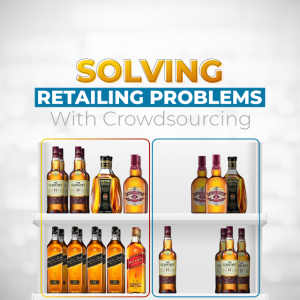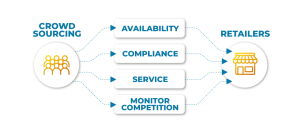Solving Retailing Problems With Crowdsourcing
Crowdsourcing, the outsourcing of tasks to a large crowd, has long helped solve global problems. With a well-designed process, crowdsourcing can help quickly assemble the data and resources needed to perform any task. As a result, it is quickly becoming the perfect tool to maximize turnover, industry reputation, and favorable customer perception by ensuring in-store merchandising compliance, benchmark operational execution, perfected product availability, and operational excellence.

Bad retail execution costs a lot of money. Crowdsourcing provides smart retail solutions by connecting retailers and suppliers to an unrivaled network of field reporters and merchandisers, keeping sales and ambitions on track.
Here are four ways in which crowdsourcing is helping retailers:
1. Availability
One of many consumer frustrations is that 5% of all products are sold out. With the loss of sales, many consumers choose a different brand or shop! That said, the task of checking whether products are available to shoppers, especially during peak hours and weekends, can be difficult for any retailer.
Crowdsourcing helps ensure on-shelf availability by providing eyes and expertise on the shop floor and delivering real-time insights on OSA and OOS to take immediate action.

2. Compliance
Improved promotional compliance by 20% could potentially lead to a turnover increase of 7%. At the store level, many things are going on simultaneously; monitoring them all can be pretty complex, especially when ensuring compliance with standard operating principles and merchandising programs, which is essential for store success.
Making sure everything is always as it should be calls for 360° visibility; crowdsourcing provides that visibility by mobilizing people on the ground to conduct field research and store audits. The crowd detects issues and opportunities in the store, optimizing your company's field teams' efforts.
3. Service
Providing quality customer experience is crucial to broadening the customer base and thus maximizing turnover. However, evaluating the level of the customer experience a brand offers can be tricky.
Through crowdsourced mystery shopping, stores can get reliable and ongoing feedback from actual customers, directly assessing customer satisfaction and evaluating how other shoppers receive the product/service. It works by getting reliable and specific feedback from a customer's point of view.
4. Monitor competition
We know that competition in the retail industry is fierce, and crowdsourcing is a fast and cost-effective tool for benchmarking so brands can learn how their business compares to the competition.
Getting real-time data on how other businesses are performing, what they are doing, the stores' conditions, etc., can help companies evaluate their business performance and find ways of improving. It can even help them assess their level of customer satisfaction and make a cross-comparison with their own business.
